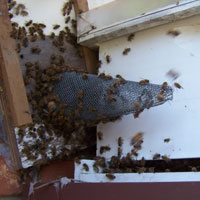 Sometimes you have a situation where doing a cutout (removing bees and comb) isn’t practical because of the location of the hive. Maybe you have a business and can’t afford to close for the amount of time it takes to remove a colony from the wall and make the repairs.
Sometimes you have a situation where doing a cutout (removing bees and comb) isn’t practical because of the location of the hive. Maybe you have a business and can’t afford to close for the amount of time it takes to remove a colony from the wall and make the repairs.
You could also have a historic building or just don’t have the access. In these cases a trapout is going to be your best bet. Keep in mind that for the first few hours of a trapout there could be quite a few bees in the air trying to figure out what’s going on, most of the time they are just confused and not angry so you shouldn’t be alarmed by this.
The Theory Behind a Trapout.
What makes a trap out work? Well the theory is that when queen senses that the foragers are not bringing in nectar and pollen anymore there must be a dearth (lack of food) and she will stop laying. When the stores that exist in the hive run out then the bees will abscond. Unless you are very lucky then the rest of the hive will pass through your cone (discussed later in this article) at this time. Unless your very lucky, they will probably go past your catch box and end up in a nearby tree. If you catch them at this time then you can place them all (including the queen) into a new hive box and move them to your apiary.
Effects of SHB on Trapouts.
If your area has problems with SHB then you should try and do your trapouts early in the spring before they have had a chance to multiply. The reason being that while your removing bees from the hive, the hive is getting weaker and may not be able to defend themselves. With that said lets cover the materials you’ll need as well as the setup of the trapout.
Materials for a trapout
1/8″ Hardware Cloth – This is used to make the cone, when you roll this make sure there is just enough room at the exit to allow 2 drones to exit together.
Silicone Caulk and a caulking gun. – For sealing up any extra entrances and sealing your new plywood entrance.
A piece of plywood – this will be used to reduce the bees existing entrance down to a manageable size and attach the cone to.
A catch box – This is what you will use to catch the bees. You can use a nuc, super, or hive body. Make sure it has all the frames except for one.
A frame of brood and eggs – You can pull one from an existing hive, this is an important part of the trapout!
Something to mount your catch box to – It’s hard to say what to use as it really depends on the environment your working in. I’ve seen good use of a ladder as a platform and I’ve seen a shelf tacked up the side of a wall when they are really high. This is going to be up for a few weeks so use common sense here and make sure it’s strong enough to withstand the elements.
The rest of the trapout is explained in this video:
Last but not least, if your doing this on someone elses property then make sure to keep them updated, let them know what your doing and what’s coming up next. Be upfront with how long it will take. If you treat this person with courtesy and respect then you will be rewarded with word of mouth advertising for trapouts, more jobs, and most importantly more free bees!






This is a great video, thank you for sharing it. I’m a little confused to if you need to have a queen in hive you are trying to get them into. I had read yes on other sites but I didn’t see or hear anything about needed a queen in the video.
Thanks!
Hi Anthony, they say there is more than one way to skin a cat, and trapouts / cutouts are no exception. I have found that if you use a frame with brood and eggs then you don’t need a queen in the catch box. When the foragers are returning they can’t get back into the hive, go to the catch box, and since they are without queen they start raising a new one. Like I mentioned in the post, you need to have a frame with brood comb and eggs, this part can’t be skipped. The brood draws the bees to the catch box and the eggs give them the means to create a new queen. With this method you can get multiple hives from a single trapout if the hive was strong. Once you have enough bees to cover 7 frames pull the catch box and replace it with another (making sure the new catch box has brood/eggs).